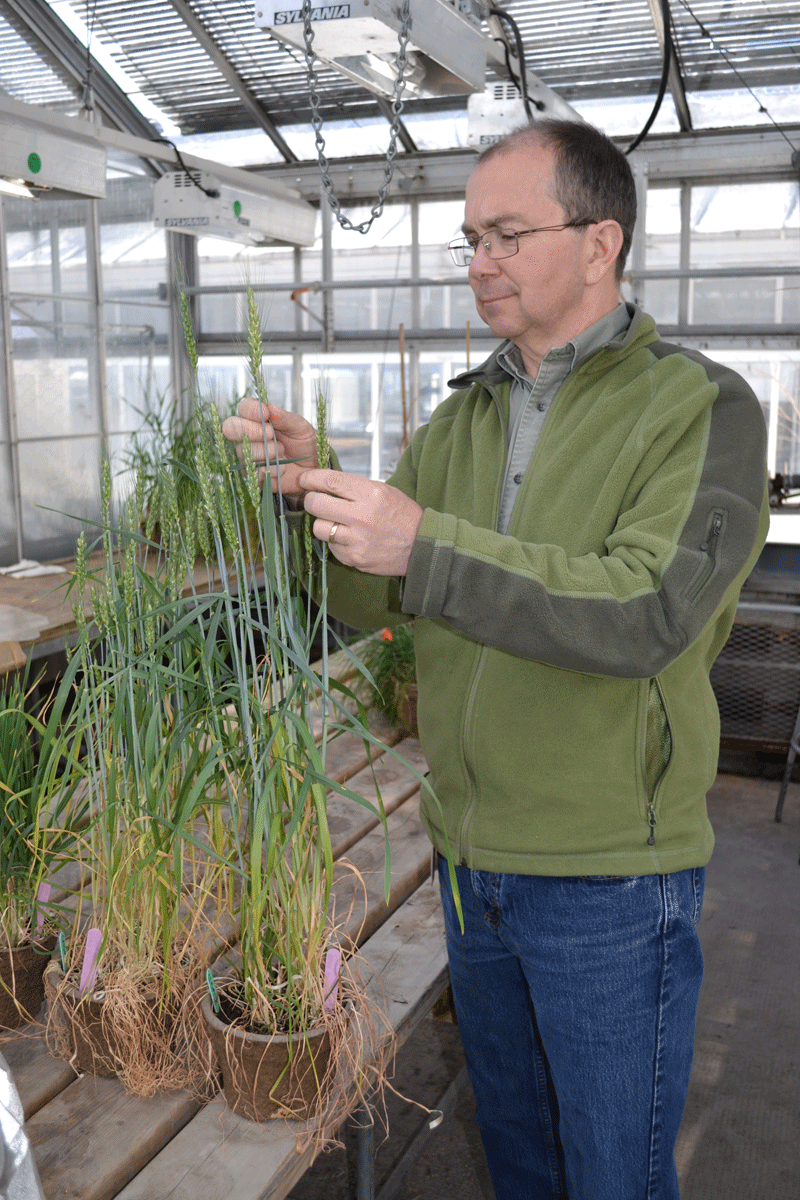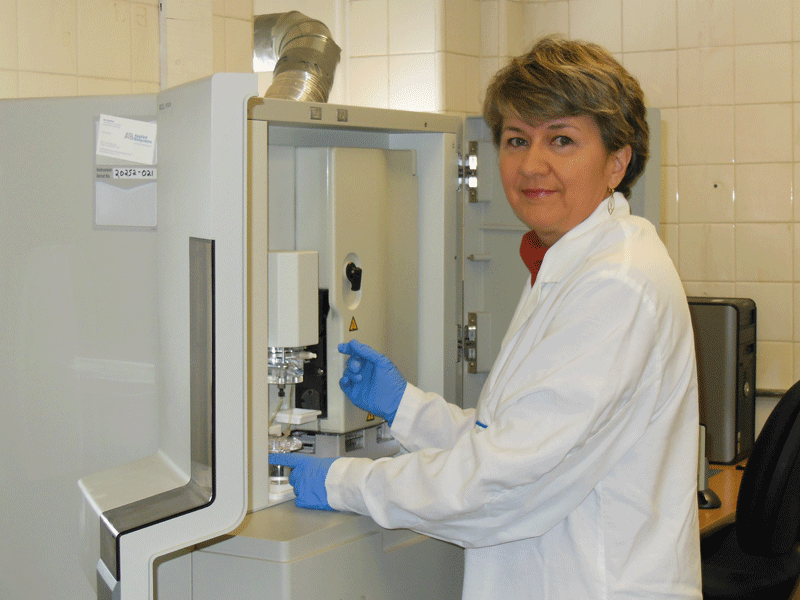Increasing wheat research
THE ADDITION OF TWO SCIENTISTS AT THE ECORC
A NEW INVESTMENT in eastern wheat research has been made with the addition of two experienced scientists to Agriculture and Agri-Food Canada’s (AAFC’s) Eastern Cereal and Oilseed Research Centre (ECORC) in Ottawa. Dr. Gavin Humphreys and Dr. Sylvie Cloutier joined the ECORC at the beginning of March.
PHOTO: DR. GAVIN HUMPHREYS.

![]()
PHOTO: DR. SYLVIE CLOUTIER.

GERMPLASM ENHANCER
Humphreys has worked for AAFC for two decades — most recently as a Senior Scientist in wheat breeding at the Cereal Research Centre in Winnipeg. His new position as a Wheat Germplasm Enhancer at the ECORC is a return to his home province. Humphreys was born and raised in Toronto; his mother’s family farmed just outside of Brampton for 150 years. “I am looking forward to the opportunity to move back to Ontario and start something new,” says Humphreys.
Five years of funding has been provided to begin a Hard Red Winter (HRW) wheat breeding program through Growing Forward 2. “Traditionally, winter wheat in Ontario has been soft wheat and the idea was to create an opportunity for eastern producers to deliver direct to the mills that same hard wheat that is now being railed from Western Canada,” explains Humphreys. “With this program there is the opportunity to grow winter wheat that isn’t just for pastries or for feed, but suitable for milling and baking bread for example.”
Humphreys has a track record of creating successful new varieties for western wheat producers. In 2000, he took on the program for Hard White Spring (HWS) for Western Canada and Canada Western Red Spring (CWRS) wheat for the northern Parkland region of western Canada where a short season, early maturity is required. He has released six varieties for baking/food purposes — four HWS wheat varieties and two CWRS wheat varieties. Because the CWRS varieties he developed were targeted for the regions with shorter growing seasons, they are earlier maturing but lower yielding. In contrast, the HWS varieties can be grown across the Prairies.
“Hard white was interesting because it was a brand new class,” says Humphreys. “The first varieties we thought were really good, but then when they got into the end users hands we found they weren’t. They didn’t have strong enough gluten for the end uses and the baked goods the baking companies wanted to use them for, so we actually had to go back to the drawing board and build new varieties with stronger, better dough strength that was more suitable for the whole wheat products these flours were going into.”
Humphreys has also been involved with field evaluations relating to work with molecular mapping and phenotyping. Some of his molecular mapping work has been looking for quantitative trait loci associated with pre-harvest sprouting resistance. He has also coordinated wheat registration trials. “Even though I have a spring wheat background I’m hoping it will be of value in my efforts to build high quality milling wheat for eastern Canada,” says Humphreys.
In addition to switching his research from spring wheat to winter wheat, Humphreys will also re-focus his efforts on making crosses, developing early generation populations, and accelerating the breeding process through the application of molecular markers.
“Because it is winter wheat, you don’t have the luxury of a winter nursery so you can’t do two generations in a year. It will be a number of years before we actually have material that I have initiated that will be at the stage for variety registration,” explains Humphreys. The goal is for the material he develops to be picked up by a seed company who would then sponsor it in a registration trial.
He already has a few ideas on where to begin his research. “Fusarium head blight (FHB) is a problem in Ontario, as it is in most high moisture producing regions, so that will be an area that I will be spending a fair amount of time on. From previous work that I have done, I know the Europeans have worked very hard to track down what resistance they have in their background, so looking at that resistance and trying to transfer it into a Canadian background would be one approach. We also have initiatives with China that we are starting up. A lot of the initial resistance to FHB used in spring wheat backgrounds came out of Chinese material, so we have a chance to see if winter material has Fusarium resistance that we could move into the Canadian background.”
“I’m looking forward to helping to make wheat an important crop and increase its value in the rotation of crops,” says Humphreys.
WHEAT GENOME PROGRAM
While Humphreys is involved in starting a new program, Dr. Sylvie Cloutier relocated her entire molecular lab and genomic program from Winnipeg to the ECORC. The six week moving process involved packing up 30 pieces of equipment, including sequencers, thermal cyclers, a gel documentation system, centrifuges, and a bio-analyzer.
“I’m not looking forward to setting up the lab again!” joked Cloutier just before the final pieces of equipment were picked up by the moving company. But she is very excited by the opportunity to transfer her research to Ottawa. “I’m looking forward to expanding the research I do on wheat, the opportunity to collaborate with other researchers, and being in a position to work with universities in both Ontario and Quebec.”
Cloutier has been a scientist with AAFC in Winnipeg since 1996. Her previous research involved both flax and wheat, but she will now focus exclusively on wheat. “I plan to work on rust diseases, wheat midge — which is an insect, and continue to work in the novel field of epigenetics.”
Cloutier explains, “in a nutshell, epigenetics can provide the tool for rapid adaptation of plants.” She says it is a comparatively new area of science that researchers have been using for less than two decades. Modifications are made that allow one gene to be more enhanced than another. These are not structural changes within the DNA sequence, rather the changes can affect the RNA which influences the expression of genes.
For example, epigenetics can provide plants with rapid adaptation to changes in environmental conditions such as droughts or increased atmospheric CO2 levels associated with climate changes.
This type of research work has always been of interest to Cloutier. “I’m naturally a curious person. Research attracted me because it involves a wide scope of decision making, and it allows me to decide what I feel is worth investigating.”
Born near Quebec City, Cloutier completed her undergraduate degree at Laval before obtaining her masters at the University of Guelph and her PhD at the University of Montreal. Much of Cloutier’s original research, including work for her masters and PhD, was in canola. “Canola at that time in the 1980s was not grown in the province of Quebec but I was aware it was being grown out west. And I wanted to see if it could be grown in the east.”
However, Cloutier also worked with wheat during that time period and her original position with AAFC was as a wheat scientist. Even though she has put more hours into flax research over the past decade, she never really stopped working on wheat genetics in the areas of pathology, entomology, and breeding.
The closure of the Cereal Research Centre in Winnipeg was announced in 2012 and Cloutier knew that she would be moving her program this spring. However, it was not until December 2013 that she was offered to transfer to Ottawa.
“Being in Ottawa provides a great opportunity to work with a wide variety of people from different locations,” says Cloutier. •

















